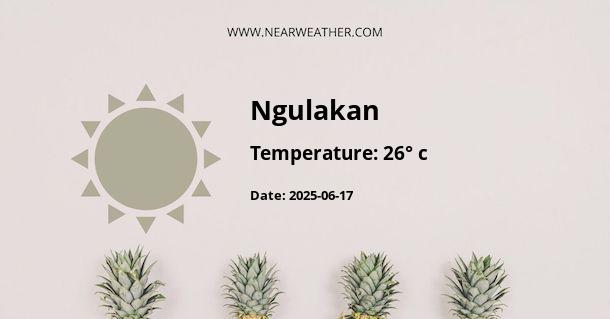Ngulakan, Indonesia: Climate and Weather Overview
Ngulakan is a small village located in the Ngawi Regency of East Java, Indonesia. Situated in the tropical zone, Ngulakan experiences a unique climate that is characterized by distinct wet and dry seasons. Understanding the weather patterns in Ngulakan is crucial for both residents and visitors to effectively plan various activities throughout the year.
Annual Climate Summary for Ngulakan
Before we delve into the specifics of Ngulakan's weather, let's take a look at the annual climate summary for the region:
| Month | Average High (°C) | Average Low (°C) | Rainfall (mm) |
|---|---|---|---|
| January | 30 | 23 | 290 |
| February | 30 | 23 | 260 |
| March | 30 | 23 | 240 |
| April | 31 | 23 | 180 |
| May | 32 | 23 | 120 |
| June | 32 | 24 | 60 |
| July | 32 | 24 | 30 |
| August | 33 | 24 | 20 |
| September | 33 | 24 | 30 |
| October | 33 | 24 | 80 |
| November | 32 | 24 | 140 |
| December | 31 | 23 | 240 |
Ngulakan's Wet Season (November-April)
Ngulakan experiences its wet season from November to April. During this period, the region receives the majority of its annual rainfall, with precipitation peaking in January. The wet season brings lush, green landscapes and provides vital water resources for agriculture and local ecosystems. However, heavy rainfall can also lead to flooding and transportation disruptions in the area.
Ngulakan's Dry Season (May-October)
The dry season in Ngulakan occurs from May to October. This period is characterized by significantly lower rainfall and higher temperatures, creating drier and sunnier conditions. The reduced precipitation allows for outdoor activities and agricultural practices to thrive, contributing to the local economy and community livelihoods.
Temperature Variation and Impact on Ngulakan
Ngulakan experiences relatively consistent temperatures throughout the year, with average highs ranging from 30°C to 33°C and average lows ranging from 23°C to 24°C. This moderate temperature range is favorable for outdoor pursuits and agricultural productivity. However, the village is susceptible to heat-related challenges, particularly during the dry season, necessitating effective heat management strategies for residents and agricultural activities.
Climate-resilient Strategies in Ngulakan
Given the distinct wet and dry seasons, residents and local authorities in Ngulakan have implemented various climate-resilient strategies to mitigate the impacts of extreme weather events and leverage the benefits of the region's climate. These strategies include:
- Infrastructure development for flood control and drainage systems
- Water conservation and storage initiatives for the dry season
- Agricultural diversification for resilience to changing weather patterns
- Community education on climate-smart practices and disaster preparedness
Conclusion
Ngulakan's climate exhibits a distinctive pattern of wet and dry seasons, shaping the village's social, economic, and environmental dynamics. Understanding the nuances of Ngulakan's weather is essential for informed decision-making and sustainable development in the region. By embracing climate-resilient approaches, Ngulakan can harness its climatic diversity for the well-being of its inhabitants and the preservation of its natural resources.
A - Ngulakan's Latitude is -6.776100 & Longitude is 111.224800.
A - Weather in Ngulakan is 31° today.
A - Climate Conditions in Ngulakan shows overcast clouds today.
A - Humidity in Ngulakan is 69% today.
A - Wind speed in Ngulakan is 4.97 km/h, flowing at 3° wind direction. today.
